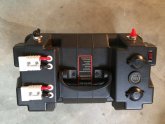Hi,
I think I’m getting more confused with the most appropriate setup with the more I read.
Apologies if a similar thread has been posted before.
My aim is to be able to go away with my vehicle for a 1-2 weeks off grid with sometimes stopping to hike for 2-3 days at a time.
I’m keen to run my fridge (Waeco CFX45), some LED lights around the truck and power my phone, iPad and USB speaker.
Ideally I’d like something that is portable and with little hardwiring to the vehicle so it can be portable between trucks.
I don’t think I need the 230V AC output, but would need 12V and USB output.
I’m based in Australia.
I’d like to build myself but obviously if its cheaper to buy as a single package I’ll go with that.
So I was thinking of 150Ah AGM battery paired to 150-200W of portable solar panels or solar blanket.
Is it possible to charge from the 12V socket in the truck or does it need a direct connection to the alternator?
Is a DIY job possible? Should I be looking at plug and play generators? Like this one?
Thanks in advance!
I think I’m getting more confused with the most appropriate setup with the more I read.
Apologies if a similar thread has been posted before.
My aim is to be able to go away with my vehicle for a 1-2 weeks off grid with sometimes stopping to hike for 2-3 days at a time.
I’m keen to run my fridge (Waeco CFX45), some LED lights around the truck and power my phone, iPad and USB speaker.
Ideally I’d like something that is portable and with little hardwiring to the vehicle so it can be portable between trucks.
I don’t think I need the 230V AC output, but would need 12V and USB output.
I’m based in Australia.
I’d like to build myself but obviously if its cheaper to buy as a single package I’ll go with that.
So I was thinking of 150Ah AGM battery paired to 150-200W of portable solar panels or solar blanket.
Is it possible to charge from the 12V socket in the truck or does it need a direct connection to the alternator?
Is a DIY job possible? Should I be looking at plug and play generators? Like this one?
Rockpals 250-Watt Portable Generator Rechargeable Lithium Battery Pack Solar Generator with 230V AC Outlet, 12V Car, USB Output Off-Grid Power Supply : Amazon.com.au: Garden
Rockpals 250-Watt Portable Generator Rechargeable Lithium Battery Pack Solar Generator with 230V AC Outlet, 12V Car, USB Output Off-Grid Power Supply : Amazon.com.au: Garden
www.amazon.com.au
Thanks in advance!





